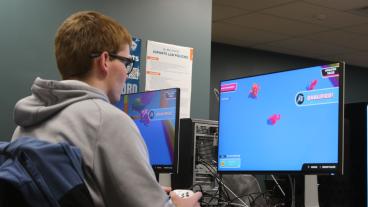Microbes, pasta, oil and water were the recipe for first place in this fall’s CECS Senior Design Trade Fair by Team OG Effluent Solutions, who built an active filtration system using microbes to treat hydraulic fracking wastewater.
The trade fair is a creative, multidisciplinary design experience emerging from combined efforts in civil, electrical, mechanical, and environmental specialties in engineering and part of the College of Engineering & Computational Sciences.
The winning team consists of four environmental engineering seniors: Eric Hake, Mengyuan Yu, Katie Schumacher and Stephen Bryers; and two civil engineering seniors: Joseph Verissimo and Jacob Draper. The team cited their client, Department of Civil and Environmental Engineering PhD candidate Stephanie Riley, as one of the key motivators in their year-long research project.
“As an undergraduate, often you build something for a research project, and then it ends up just sitting on a shelf – or worse,” explained Jake Draper. “In our case, we were incorporating our work into an existing project that grad students would be using for years to come. So we were motivated to build a high quality system that would continue to function long after we’ve graduated.”
The team’s mission, to develop and test a pilot scale biologically active filtration (BAF) system, stemmed from nanofiltration research taking place at Mines’ Advanced Water Technology Center (AQWATEC).
“More than two billion gallons of fracking wastewater are produced every day in America,” said Katie Schumacher. “Right now the primary disposal method is deep well injection, which isn’t sustainable in the long term. Our project is a pretreatment system for ultra-filtration membranes, which could lead to that wastewater being useful rather than wasted.”
The team built three pilot scale BAF systems and tested different conditions to find which allowed the microbes to grow fastest, leading to an increase in the removal of organics.
“We ran frack water through the columns, and essentially what happens is that these little bugs attach to the medium – tiny plastic pieces that we call pasta because – well, they look like tiny pasta shapes,” said Erick Hake, who worked on the project throughout the summer at Mines. “They allow the microbes, the biomass, to grow. The biomass then metabolizes and removes organics from the water.”
Even before the team won first place, several of the members expressed their gratitude for working on a project with real applications for advancing research.
“Building the hydraulic system was fun,” said Draper, “but it wasn’t our primary focus.”
“Figuring out the optimal operating conditions was our real goal,” continued Schumacher.
Their faculty advisor, Assistant Professor Kate Smits, agreed. “Part of their success was the amazing participation from their client, Stephanie Riley, and their technical adviser, Tzahi Cath, who really took the team under their wings and integrated them into their research team. The system, procedure and results will continue to be carried on by Stephanie Riley as part of her graduate thesis work.”
Associate Professor Tzahi Cath is hopeful that the team’s success will influence future Senior Design projects. “It makes a lot of sense to connect teams to ongoing, funded projects on campus,” said Cath. “The seniors feel that they are part of a real project, that their design matters, and that the product of their project will continue to be used after they are done.”
Both Smits and Cath noted that the quality of the team ultimately determined its success. “OG Solutions is a unique combination of very smart and very dedicated students, with a lot of hands on experience,” said Cath. “Most importantly, they were open to listen, to learn, and to implement what they learned, most often coming up with better solutions. Their success was also highly attributed to the dedicated mentoring by Stephanie Riley, and the AQWATEC technician, Mike Veres. Above all, I am proud of the data that the students have generated – at or above the level of data that graduate students are generating.”
Congratulations to all this semester’s Senior Design Trade Fair winners:
Overall Trade Fair Winners
- 1st Place – OG Effluent Solutions (S15-09): Students: Eric Hake, Joseph Verissimo, Mengyuan Yu, Jacob Draper, Katie Schumacher, Stephen Byers; Client: Stephanie Riley; Faculty Advisor: Dr. Kate Smits; Consultant: Dr. Tzahi Cath; Project: Biologically Active Filtration
- 2nd Place – Pub Bike Racer (S15-08): Students: Matthew Alemann, Jens Cole, Phu Nguyen, Martin Vincentelli, Julianne Wilson, Gabriel Yaakob; Client: Dr. Robert Amaro; Faculty Advisor: Ryan Miller; Consultant: Dr. Cameron Turner; Project: 1976 Honda CB550 Retro-mod
- 3rd Place – Colorado Precision Solutions (S15-07): Students: Jesse Arnold, Spencer Connor, Matt Edwards, Tyler Kordziel, Rachel Newman, Ebrahim Nobakht; Client: Dr. Aaron Stebner; Faculty Advisor: Buddy Haun; Consultant: Dr. Xiaoli Zhang; Project: Precision Axis Alignment Fixture for Microtesting
Essay Contest Winners
- 1st Place – “Material Makes the Impact” by Katarina Bujnoch
- 2nd Place – “Thunder Valley: How Renewable Energy Can Benefit a Community” by Aleithia Toews
- 3rd Place – “The Power of a Simple Element” by Katie Schumacher
The winning teams, as well as an outstanding graduating senior from each CECS degree program, will receive plaques at the CECS Graduation Reception on Dec. 17 in the Student Ballrooms A and B.
Contact:
Deirdre Keating, Information Specialist, College of Engineering & Computational Sciences | 303-384-2358 | dkeating@mines.edu
Karen Gilbert, Director of Public Relations, Colorado School of Mines | 303-273-3541 | kgilbert@mines.edu



